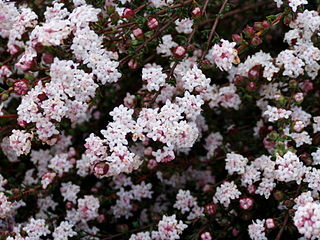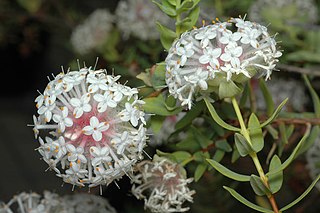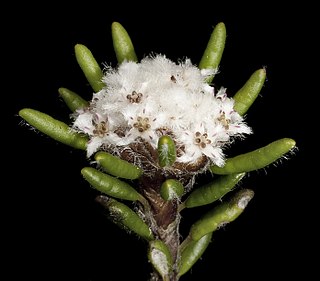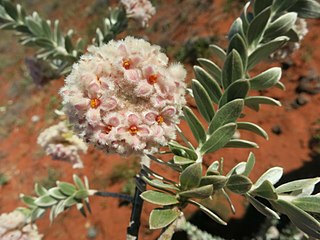
Pimelea congesta is a species of flowering plant in the family Thymelaeaceae and is endemic to Lord Howe Island in Australia. It is a shrub with rough bark, decussate, elliptic leaves and heads of white flowers.

Pimelea brachyphylla is a species of flowering plant in the family Thymelaeaceae and is endemic to the south-west of Western Australia. It is an erect to spreading shrub with linear to elliptic leaves and clusters of white, tube-shaped flowers.

Pimelea curviflora, also known as curved rice-flower, is a shrub in the family Thymelaeaceae and is endemic to Australia. It is a small, hairy shrub with greenish-yellow or red tubular flowers.

Pimelea amabilis is a species of flowering plant in the family Thymelaeaceae and is endemic to northern Queensland. It is a small shrub with narrowly elliptic or elliptic leaves and spikes of hairy, yellowy-green or yellow, tube-shaped flowers.
Pimelea approximans is a species of flowering plant in the family Thymelaeaceae and is endemic to northern Queensland. It is a perennial shrub with elliptic leaves and spikes of hairy, yellow, tube-shaped flowers.
Pimelea aquilonia is a species of flowering plant in the family Thymelaeaceae and is endemic to far north Queensland. It is a shrub with narrowly elliptic leaves and small clusters of hairy, white or cream-coloured, tube-shaped flowers.

Pimelea argentea, commonly known as silvery leaved pimelea, is a species of flowering plant in the family Thymelaeaceae and is endemic to the south-west of Western Australia. It is an erect shrub with densely hairy young stems and leaves, the leaves linear to elliptic, and heads of white to yellow or greenish flowers, the male and female flowers on separate plants.

Pimelea avonensis is a species of flowering plant in the family Thymelaeaceae and is endemic to the south-west of Western Australia. It is a shrub with narrowly egg-shaped or elliptic leaves and clusters of white, tube-shaped flowers.
Pimelea cinerea is a species of flowering plant in the family Thymelaeaceae and is endemic to Tasmania. It is a slender shrub with more or less elliptic leaves, and heads of white flowers surrounded by leaves.
Pimelea clavata is a species of flowering plant in the family Thymelaeaceae and is endemic to near-coastal areas and offshore islands of southern Western Australia. It is an erect shrub with narrowly elliptic to more or less linear leaves arranged in opposite pairs, and head-like clusters of white to pale yellow, tube-shaped flowers surrounded by leaf-like involucral bracts.
Pimelea elongata is a species of flowering plant in the family Thymelaeaceae and is endemic to inland areas of eastern Australia. It is a slender forb with linear to narrowly elliptic leaves and spikes of hairy, yellowish-green flowers.

Pimelea confertiflora is a species of flowering plant in the family Thymelaeaceae and is endemic to north Queensland. It is a shrub with densely hairy young stems, elliptic or narrowly elliptic leaves and spikes of yellowish-green or yellow, tube-shaped flowers.
Pimelea fugiens is a species of flowering plant in the family Thymelaeaceae and is endemic to central Queensland. It is a shrub with elliptic leaves and heads of 12 to 18 pale yellow, tube-shaped flowers.

Pimelea gigandra is a species of flowering plant in the family Thymelaeaceae and is endemic to eastern Australia. It is a shrub with densely hairy young stems, elliptic leaves and heads of 10 to 19 white, tube-shaped flowers.

Stenanthemum humile is a species of flowering plant in the family Rhamnaceae and is endemic to the southwest of Western Australia. It is a low, erect perennial herb or shrub with white, woolly-hairy young stems, linear to narrowly elliptic leaves and densely, woolly-hairy heads of tube-shaped flowers.

Pimelea interioris is a species of flowering plant in the family Thymelaeaceae and is endemic to a restricted part of the south of the Northern Territory of Australia. It is a shrub with hairy, narrowly elliptic leaves and clusters of creamy-white to pale yellow, separate male and female flowers.
Pimelea lanata is a species of flowering plant in the family Thymelaeaceae and is endemic to the southwest of Western Australia. It is a shrub with narrowly elliptic leaves and erect clusters of white to deep pink flowers surrounded by 4, mostly green, involucral bracts.

Pimelea latifolia is a species of flowering plant in the family Thymelaeaceae and is endemic to eastern Australia. It is a shrub with hairy young stems, egg-shaped leaves with the narrower end towards the base, and greenish-yellow to white, tube-shaped flowers.

Stenanthemum pimeleoides, commonly known as spreading stenanthemum or propellor plant, is a species of flowering plant in the family Rhamnaceae and is endemic to Tasmania. It is a small, prostrate, mat-forming shrub with hairy young stems, egg-shaped leaves with the narrower end towards the base, and densely hairy clusters of tube-shaped flowers surrounded by conspicuous, whitish floral leaves.
Pimelea leptospermoides, commonly known as serpentine rice flower, is a species of flowering plant in the family Thymelaeaceae and is endemic to Queensland. It is a shrub with narrowly egg-shaped to elliptic leaves and white, tube-shaped flowers arranged in groups of up to 7.











